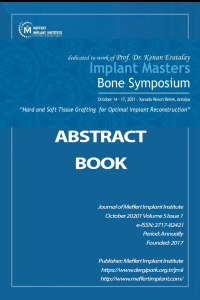Comparative Biomechanical Evaluation of Combined Cement- and Screw-Retained Implant-Supported Restorations with 3D Finite Element Analysis
Abstract
Introduction: Implant restorations may need to be removed in case of mechanical and biological complications or renewal of the restorations. For this purpose, the combined cement- and screw-retained implant-supported restorations have gained increasing interest in implant dentistry because they combine the advantages of cemented and screw-retained restorations to a great extent and reduce their disadvantages.
The purpose of this study was the comparative biomechanical evaluation of combined cement- and screw-retained implant-supported metal-ceramic, zirconia, and monolithic zirconia restorations using the 3D finite element stress method.
Materials and Methods: In the study, 3 jawbone models were prepared. Dense cortical bone (2 mm) and thick trabecular bone type below, which is seen 50% in the posterior region of the mandible, were modeled and the material properties of these bone types were defined. Titanium implants with a diameter of 4 mm and a length of 10 mm were placed on these jaw models. Then, metal-ceramic, zirconia, and monolithic zirconia restorations were modeled on the placed implants. Considering the worst-case scenario, an average occlusion force of 100 N was applied obliquely (30° to the x, y, and z axes) in the distal triangular fossa of the crowns. As a result of the study, the stress distributions and values obtained in the implant components and peri-implant tissues were analyzed and interpreted.
Results: It is observed that the stresses occurring in the bone, restoration, implant, and implant components occur below the durability level of the structures. In addition, stress values and distributions in metal-ceramic, zirconia, and monolithic zirconia models were similar.
Discussion & Conclusion: Metal-ceramic, zirconia, and monolithic restorations can be used safely in a combined cement and screw-retained implant-supported system.
Keywords
Combined cement- and screw-retained implant-supported restoration 3-dimensional finite element analysis metal-ceramic zirconia monolithic zirconia
Project Number
TCD-2020-1556
References
- Journal of Meffert Implant Institute Implant Master Symposium
Kombine Siman ve Vida Tutuculu İmplant Destekli Restorasyonların 3 Boyutlu Sonlu Elemanlar Analiziyle Karşılaştırmalı Biyomekanik Değerlendirilmesi
Abstract
Giriş: Mekanik ve biyolojik komplikasyonlar veya restorasyonların yenilenmesi durumunda implant restorasyonların çıkarılması gerekebilir. Bu amaçla, kombine simante ve vida tutuculu restorasyonlar, simante ve vida tutuculu restorasyonların avantajlarını büyük oranda birleştirip, dezavantajlarını azaltması nedeniyle implant diş hekimliğinde artan bir ilgi kazanmıştır.
Bu çalışmanın amacı, 3 boyutlu sonlu elemanlar stres analiz yöntemi kullanılarak kombine siman ve vida tutuculu implant destekli metal-seramik, zirkonya ve monolitik zirkonya restorasyonların karşılaştırmalı biyomekanik değerlendirilmesidir.
Materyal ve Metod: Çalışmada 3 adet çene kemiği modeli hazırlandı. Mandibula posterior bölgede %50 oranında görülen yoğun kortikal kemik (2 mm) ve altında kalın trabeküler kemik tipi modellenerek ve bu kemik tiplerine ait materyal özellikleri tanımlandı. Bu çene modelleri üzerine 4 mm çapında ve 10mm uzunluğunda titanyum implantlar yerleştirildi. Daha sonra yerleştirilen implantlar üzerine metal-seramik, zirkonya ve monolitik zirkonya restorasyonlar modellendi. En kötü senaryo düşünülerek ortalama olarak 100 N'luk bir oklüzyon kuvveti, oblik olarak (x, y ve z eksenlerine 30°) kronların distal triangular fossasına gelecek şekilde uygulandı. Çalışma sonucunda implant komponentleri ve peri-implant dokularda elde edilen stres dağılımları ve değerleri incelenerek yorumlandı.
Bulgular: Kemik, restorasyon, implant ve implant komponentlerinde oluşan streslerin yapıların dayanıklılık seviyesinin altında oluştuğu görülmektedir. Ayrıca metal-seramik, zirkonya ve monolitik zirkonya modellerde oluşan stres değerleri ve dağılımları benzerlik göstermiştir.
Tartışma ve Sonuç: Metal-seramik, zirkonya ve monolitik restorasyonlar kombine siman ve vida tutuculu implant destekli sistemde güvenle kullanılabilir.
Keywords
Kombine siman ve vida tutuculu implant destekli restorasyon 3 boyutlu sonlu elemanlar analizi metal-seramik zirkonya monolitik zirkonya
Supporting Institution
İnönü Üniversitesi Bilimsel Araştırma Projeleri Koordinasyon Birimi
Project Number
TCD-2020-1556
References
- Journal of Meffert Implant Institute Implant Master Symposium
Details
| Primary Language | English |
|---|---|
| Subjects | Dentistry |
| Journal Section | Articles |
| Authors | |
| Project Number | TCD-2020-1556 |
| Publication Date | October 26, 2021 |
| Published in Issue | Year 2021 Volume: 5 Issue: 1 |

